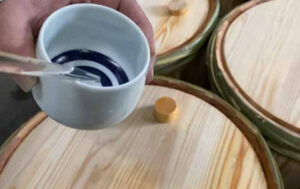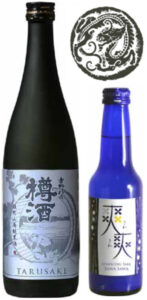The pursuit of quality
Nara Prefecture is quite famous, among others, for its cute encounter with deers in Nara Park. But, the city of Nara has been the capital of Japan 1300 years ago and its history is strongly bond with the sake brewing culture. Indeed, the area has got a lot of shrines and some of them are link to Nihonshu*. For instance, it is said that the oldest shrine of Japan, Omiwa-jinja, is home of the god of sake and Shouryakuji temple is the first one to have brew Nihonshu.
It is then natural to  have many sake breweries in Nara Prefecture like Choryo Shuzo. Founded in 1963 by the youngest of seven brothers in a sake brewing family, Teiichi Iida, this Maison is well-known by sakes lovers as they have a specialty: Tarusake. In the past, every sake was a Tarusake, meaning that it was stored in cedar barrels mainly for transportation. This woody aromatic sake disappeared with the appearance of glass bottles, but Teiichi Iida could not bear the loss of this historical traditional product. He decided then to create a bottled Tarusake in 1964 using the magnificent Yoshino cedar.
have many sake breweries in Nara Prefecture like Choryo Shuzo. Founded in 1963 by the youngest of seven brothers in a sake brewing family, Teiichi Iida, this Maison is well-known by sakes lovers as they have a specialty: Tarusake. In the past, every sake was a Tarusake, meaning that it was stored in cedar barrels mainly for transportation. This woody aromatic sake disappeared with the appearance of glass bottles, but Teiichi Iida could not bear the loss of this historical traditional product. He decided then to create a bottled Tarusake in 1964 using the magnificent Yoshino cedar.
In the south of Nara Prefecture, we can find the Yoshino Forest: the first man-made forest which for 500 years has crafted the techniques of growing cedar trees. The barrels of Choryo Shuzo are made with 80 years old trees. Only a certain part of the heart, called “Koutsuki”, is kept to shape the staves and no nails are used to assembly the Taru, the barrel.
Yoshinosugi no Tarusake – Yamahai Omachi is (re)born. This Nihonshu is 100% Omachi rice which gives richness and umami. Moreover, the Yamahai method is used: it is a traditional production method allowing the lactic bacterias and then the strongest yeasts to strive. Yamahai sakes are full-bodied with a great diversity of aromas and a nice acidity. Finally, the ageing in cedar barrel is about 1 month, which is quite long. In the nose, we can feel the power and the delicate flavors of cedar. The second nose opens with more intensity, rice touch and some fruits like lemon. The mouth is fresh almost minty with a nice acidity and umami. We have the cedar notes and a great bitter hint at the end of the tasting which allows this sake to be so gastronomic. The finish is amazingly long. It is a great Nihonshu with complexity and different textures.
 If Choryo Shuzo loves the past, they are also deeply rooted in the present. It is why they decided to create Sawa Sawa, a sparkling sake. The bubbles are not added: it is a secondary fermentation in bottle, like the Champagne method, which brings the fizz. This Junmai saké (70% polishing ratio) is slightly cloudy. The first nose is fresh with some coconut water and rice notes. The second nose brings more fruits like apple and almond. The mouth is fresh, fizzy with dynamism. The attack is sweet with coconut water, rice, apple and melon flavors. The finish is floral. It is an easy drinking (but always with moderation) refreshing saké which has 8-9% alcohol.
If Choryo Shuzo loves the past, they are also deeply rooted in the present. It is why they decided to create Sawa Sawa, a sparkling sake. The bubbles are not added: it is a secondary fermentation in bottle, like the Champagne method, which brings the fizz. This Junmai saké (70% polishing ratio) is slightly cloudy. The first nose is fresh with some coconut water and rice notes. The second nose brings more fruits like apple and almond. The mouth is fresh, fizzy with dynamism. The attack is sweet with coconut water, rice, apple and melon flavors. The finish is floral. It is an easy drinking (but always with moderation) refreshing saké which has 8-9% alcohol.
Choryo Shuzo proposes different styles but with only one philosophy: “Shodo Mukyukyoku”. Shodo means that “the path of sake brewing is demanding and infinitely wide”. Mukyukyoku underlines the fact that this path has got no end. Though the pursuit of quality has no limit for them.
*Nihonshu refers to the Geographical Indication (GI) of Japanese Sake made in Japan with Japanese ingredients.
